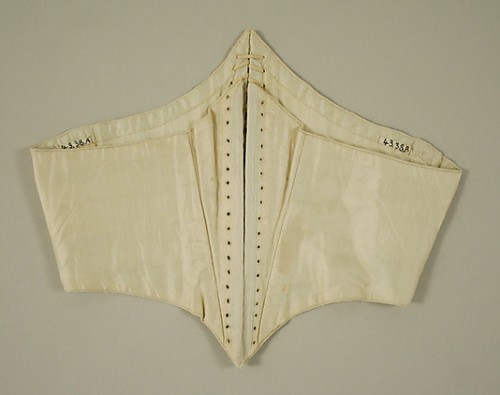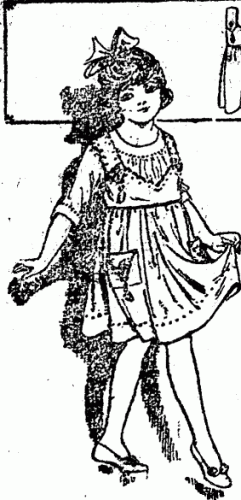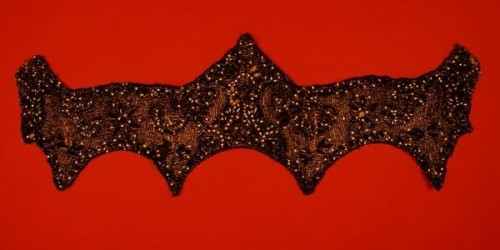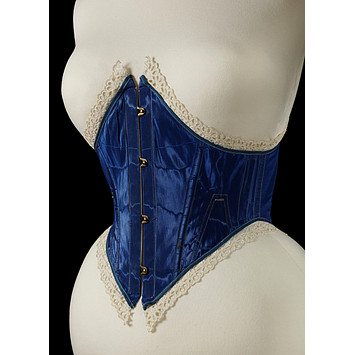For this week’s terminology post I go back to last week’s Rate the Dress, and Rae’s comment about whether Victorian women wore corsets outside of their dresses.
The simple answer is, they didn’t. But they did wear Swiss waists & corselets outside of their dresses, and these can look a lot like corsets if you don’t look closely. So what are these things, and how are they different from corsets?
A Swiss waist is a boned, pointed underbust garment worn over skirts and blouses or dresses. Unlike a corset, a swiss waist NEVER fastens with a metal front busk. Swiss waists can have a flat front, with no front opening, or can lace up the front with hand worked eyelets (never metal eyelets). The backs fasten with lacing (also with worked eyelets, not metal eyelets) or buttons. Swiss waists were extremely popular in the 1860s, worn by empresses and common women alike. In the 1860s they were more likely to be called corsages (an un-specific term for a bodice), swiss bodices, swiss belts, or swiss waist belts or simply waists, than swiss waists. They returned as an indispensable fashion accessory in the 1880s and 1890s, which is when the name swiss waist became common.

Corselet, 1860s, American or European, via the Met

Day costume with Swiss waist, Auckland Star, 14 March 1891 via Papers Past
Some Swiss waists from the 1860s included shoulder straps, usually trimmed with decorative pleated ribbon.

Ensemble with matching Swiss waist in lilac silk, ca. 1855, American, piña cloth, silk. Via the Met
Swiss waists are sometimes called Swiss belts, though there was sometimes the differentation that a swiss waist was higher and more corset-y, and a Swiss belt was shorter and might have attached streamers and bows that imitated a sash.

Dress with matching swiss belt, British, 1861-63, Moire silk trimmed with lace and velvet ribbon, boning, silk lining. Via the V&A

Swiss belt with back button fastening, ca 1867, French, Silk, via the Met
While the 1860s and 1890s Swiss belt was a fitted, shaped, often boned, garment, the term carried into the 20th century as a description for a design detail with a pointed belt/midriff effect, even when it was used on a loosely fitted child’s frock.

Child’s party frock with swiss belt effect, Whanganui Chronicle, Aug 1919 via Papers Past
What about ‘corselet‘? That one is a bit trickier, as it has been applied to a variety of things. Corselet is a late 19th and early-mid 20th century term for a garment with waist-emphasising midriff section. In the 1890s ‘corselet’ or ‘corselet belt’ was used almost interchangeably with ‘swiss waist’ or ‘swiss belt’ to describe a fitted, shaped belt or sash.

Evening dress with corselet-effect belt, Jeanne Hallee, 1901—5, French, silk, metallic, glass, via the Met
Corselets/Swiss waists of the 1890s were worn with both day and evening wear, and could be liberally decorated with beading and trim, or even diamonds.

Wedding bodice (swiss waist), 1896, Silk taffeta, silk satin, tulle, silk floss, silver mesh, rhinestone, pearl, silver cording, via the Chicago History Museum

Gold lame swiss waist with jet beading, late 19th century, via Live Auctioneers
From 1905 to 1915 ‘Corselet skirts’, with high waistbands, often with pointed tops or bottoms, were much in vogue.
In the first two decades of the 20th century a corselet might also refer to a softer, less boned corset.
The term returned in the 1930s to describe the pointed-underbust midriff section so common in 1930s fashion, or a pointed belt put over a garment. Elise’s blue velvet gown, blue velvet leaf gown, the floral and organza gown and pretty much every 1930s dress pattern in this post all have the first type of corselet waist.

In printed crepe-de-chine–powderblue scattered with flowers–this afternoon dress, with its little velvet bolero and corselet to match, and its 1830 sleeves, strikes an original note Evening Post, 5 September 1931 via Papers Past
What about waist cincher? What is a waist cincher? Well, it’s not a phrase that I have ever found in period literature. It may have been used, but it was certainly not in common usage. So from a historical perspective, I can’t tell you what a waist cincher is.
So what makes all of these fitted outer garments different from a corset? It’s all in the details. Corsets (we are speaking of those from the 1860s and onwards for the purpose of this post) usually lace with metal eyelets, and often fasten up the front with a metal busk – things that are never seen on Swiss waists and corselet belts. Corsets also frequently feature outer channels to hold the bones, or stitched in boning channels – details which reveal and highlight their purpose as a constricting undergarments. These details are never seen on garment that were worn as outerwear.
See the busk, boning channels, and inset gussets? It’s a corset:

Corset, silk, 1860s, English; Blue watered silk trimmed with broderie anglaise, via the V&A
See the metal eyelets and boning channels? It’s a corset:
Want to see more swiss waists, corselets, and underbust corsets? Check out my pinterest page (though be aware it is a research page, so includes garments in all categories, and I haven’t differentiated between them).
Want to make your own Swiss Waist? Catherine at Koshka the Cat provides a simple pattern based off an extent garment.






I love the blue silk Swiss Belt. Thank you for an educational and stunningly gorgeous post.
Me too! And the ballgown…wow. No joke, Dreamstress, I learned these terms in 1993 which started a lifelong passion with historical costuming. Way to bring it all full-circle!
That wedding bodice from the Chicago History Museum! Oh, my!! So beautiful. Fascinating article!
There were undergarments back in the sixties that we called ‘waspies’ – they gave you a wasp-waist, you hoped – but it took the eighties to bring them back out from under!
Isn’t it amazing! I’d love to know what the dress that went with it looked like!
Always love these terminology posts!
(Also, when I click on “3 comments” at the top of the post, it doesn’t automatically take me to the comments. Is there a way to fix that?)
I will talk to the web genius and see what we can do.
Drat. I wish you had done this a few months ago. I made a corselet and I, “gasp”, used metal grommets. Now I have to decide if I want to go to the trouble of making a faux eyelet by stitching over the metal.
I imagine the whole ‘no metal grommets’ will be a bit of a sticking point for modern costumers! I’m a huge advocate of hand-sewn eyelets, so of course I say get as close as you can and stitch over the metal.
What a wonderful, highly educational post! I’ve never made a corset or studied them much, but you’ve given me a lot of food for thought. Thank you!
In our state park of Old Town San Diego, which was supposed to have gone ‘historically accurate’ a few years ago, we see daily the restaurant hostesses wearing their corsets outside their dresses. And because they’re outside, we also see they are upside down….and backwards.
I guess they think they’re wearing Swiss belts. Even so, they’re upside down….and backwards.
Oh dear. Have you ever tried to tell them very nicely?
Ooh, fun post! I was not aware of the finer points distinguishing these. In addition to the differences between the outer garments and undergarments you mentioned my understanding is that a woman would still be wearing a corset under everything even if wearing a swiss belt, etc. That the belts are purely decorative and their boning is simply to keep the surface smooth, only the corset is intended to perform actual body shaping. Am I correct in this belief?
I also have a completely unrelated question. My husband is currently in Hawaii (for work not fun, which is why I’m not with him), is there anything in particular you would suggest that he bring back for me? ;o)
Carolyn, I was about to comment with just this! You’re very right, the Swiss waist or corselet belt is never a substitute for a proper corset underneath the dress. You can see why now, too, since they’re a lot fancier and less structurally strong.
Yes, definitely. A swiss waist is no substitute for a corsets – it’s an outer garment, you still need to wear all the proper undergarments.
Ummmm…everything that I love from Hawaii has to be eaten fresh! They do sell lovely Hawaiian fabrics, but I don’t know if that is your thing.
Oooh, so there IS good fabric there then? “Lovely Hawaiian fabric” sounds, well, lovely to me! Is there any chance you’d be able to recommend a place in or around Honolulu I could direct my husband to?
Also, since you mentioned it, is there anything(s) in particular food-wise I should recommend to him to try?
Thanks so much for indulging my totally unrelated and selfish questions!
Haha…no worries! I love Hawaii and am always happy to share it.
He MUST try malasadas – Leonards should have food truck in the corner of a the parking lo of most shopping centres/malls. You can see their trademark green and white striped truck in the first photo of this post: https://thedreamstress.com/2010/10/ono-kine-grindz/
If he’s open to raw fish I also REALLY recommend poke (marinated raw fish salad). You can buy it in the deli section at supermarkets.
I’m afraid I don’t remember the names/locations of the fabric stores in Honolulu. 🙁 We just make a list from the yellow pages and hit them all up when I’m home.
I love this post! You took on the topic and covered it so well. And with some gorgeous examples, too. Thank you!
Thank you so much for writing this! It definitely clears up my own confusion. Now I just have to convince myself that no, a swiss waist does not need to be made for the project I’m currently working on… (but will most certainly be added to the TO DO list.)
You’re welcome!
Makes sense, the name as these things echo the dirndl styles of Switzerland. I love the variety of shapes, and they are definitely flattering in most cases so little wonder the fashion keeps popping up again!
Oooh…are you making a claim to universally flattering 😉
IIRC, Te Papa has a nice Swiss waist with jet trimming.
Wonderful post, thanks for that! Actually the term ‘corselet’ still exists in modern German and refers to an undergarment of this type: http://tinyurl.com/cw4yvd4
This type of garment was very popular during the 1930s and 40s here (and was already referred to as a corselette): http://tinyurl.com/boyde5t
I think it’s interesting how names and meanings shift over times. Some people here think that corsage, corset, corselette, it’s all the same…I’ll redirect them to this post from now on^^
~*~ Ela
P.S.: It’s not clearly visible in the photo, but when studying the original extant Empress Sisi Swiss Waist, it’s really rather more of a belt 🙂
How interesting that it’s still in use in German. We also use corselet in modern English to refer to various types of boned undergarments, or shaped or boned overgarments, but the definition is very loose – everything from wrap belts to vests to any top with lacing to bustiers.
Is the extent Empress Sisi swiss waist the same one as in this photo? I’ve seen a couple of different photos of her in swiss waists, and she clearly had at least three.
Yes, I think it’s the one from this photo, or at least a very similar one in cut. I couldn’t find a photo online either in the Viennese collections nor anywhere else, but I have one in a book at home. I’ll be home again in two days time, then I’ll scan it. I’ve seen it in person as well, but photos weren’t allowed 🙁
Haha! This reminds me of the most embarrassing 15 minutes of my life in Germany. My sister was buying her wedding dress there, and put me in charge of the language. Of course, traditional wedding dresses require foundations (sometimes sort of racy foundations, too), so while the other maid and I were cleaning rooms, I would mime an undergarment, and she would tell me the name in German. My sister ended up needing a corselet!
Very fascinating post, it was great to get all these charming belts properly identified!
Do you know of any examples of any of these belts from the 1880s?
By the way, I scanned the Sisi Swiss Waist/Belt pictures for you – here are the links 🙂
http://tinyurl.com/ch2eknp
http://tinyurl.com/cusvsa6
Fantastique! I loved. Thank you so much!
[…] skirt part might work as skirt, and paired with a white blouse and a leather swiss waist it might work as steampunk […]
Can I use when, would an underbust corset be worn and in what era?
metmuseum.orgmetmuseum.orghttp://www.metmuseum.org/collection/the-collection-online/search/158029?rpp=30&pg=1&ft=corset&pos=17
Discusses the “waist cincher” – thought you might find it interesting.
[…] Next we’ve got a Swiss Waist with buttons down the front. These were corset-like (But NOT actual corsets, corsets are undergarments, they go UNDER the dress. Sorry this issue really bugs me!) garments, it will be boned and probably laces up in the back. for a better understanding on the Swiss Waist check out this excellent article. https://thedreamstress.com/2012/07/swiss-waist-waist-cincher-corset-and-corselet-whats-the-difference… […]
[WORDPRESS HASHCASH] The comment’s server IP (192.0.100.87) doesn’t match the comment’s URL host IP (192.0.78.12) and so is spam.